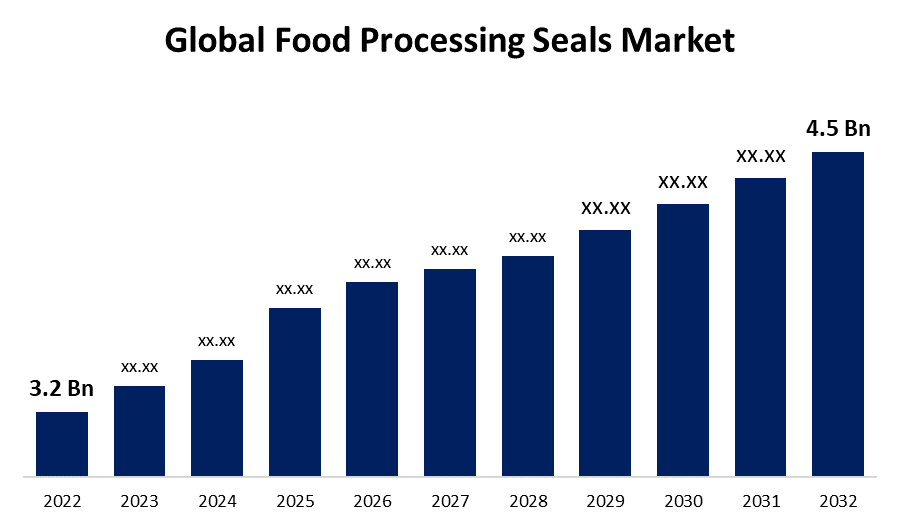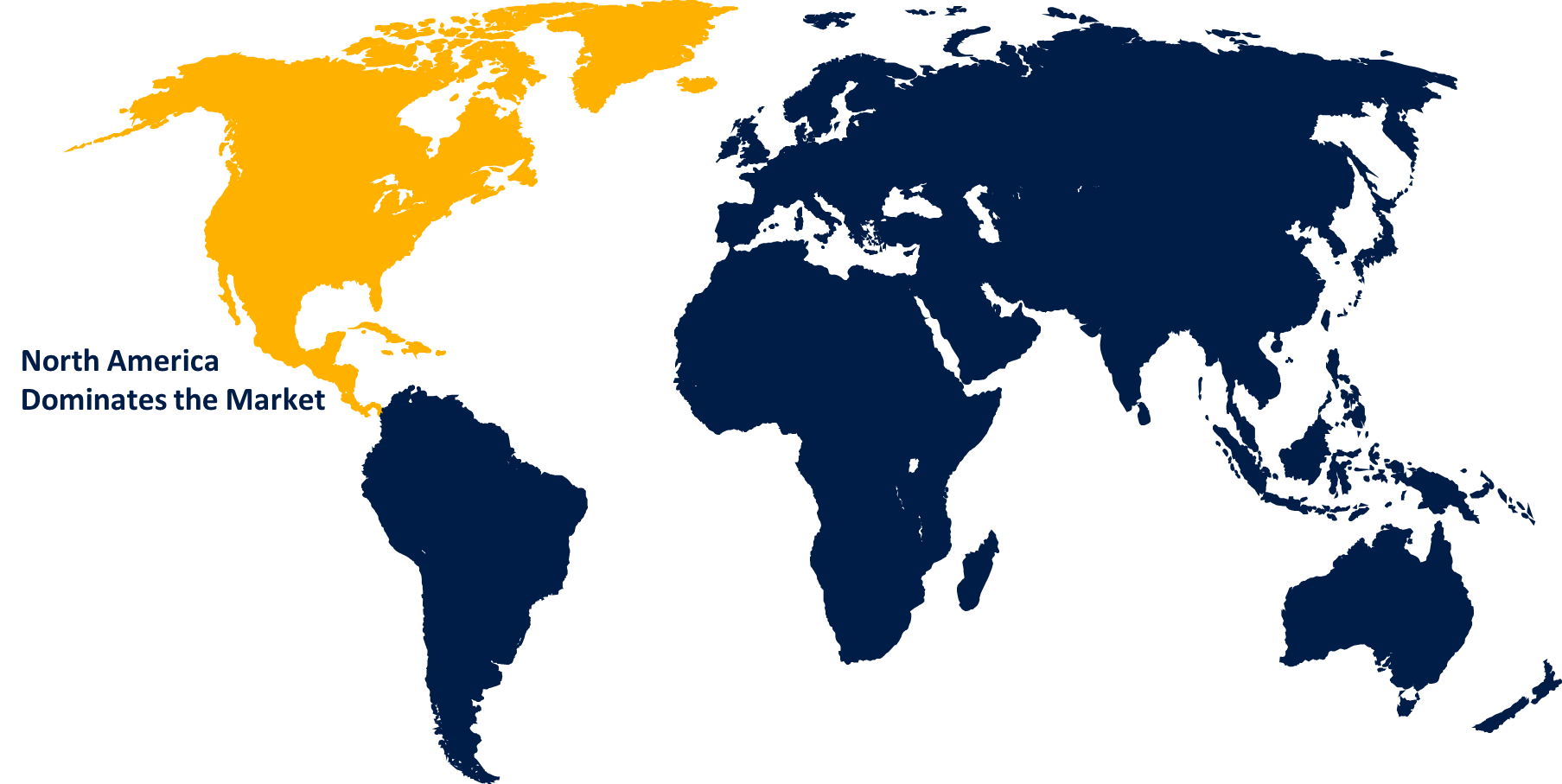Global Food Processing Seals Market Size By Material (Face Materials, Metal, Elastomers), By Application (Bakery & Confectionery, Beverages), By Region, And Segment Forecasts, By Geographic Scope And Forecast to 2032
Industry: Food & BeveragesGlobal Food Processing Seals Market Insights Forecasts to 2032
- The Global Food Processing Seals Market Size was valued at USD 3.2 Billion in 2022
- The Market Size is Growing at a CAGR of 3.1% from 2022 to 2032
- The Worldwide Food Processing Seals Market Size is expected to reach USD 4.5 Billion by 2032
- Asia-Pacific Market is expected to grow the fastest during the forecast period

Get more details on this report -
The Global Food Processing Seals Market Size is expected to reach USD 4.5 Billion by 2032, at a CAGR of 3.1% during the Forecast period 2022 to 2032.
The rules of the game are changing as a result of innovations like high-pressure processing, microwave-assisted thermal sterilisation, and other cutting-edge technology. Natural, organic, and minimally processed foods are in greater demand as people become more health conscious. The market for food processing is heavily influenced by international trade. As a result of the frequent sourcing of materials from throughout the globe, supply chain management is essential. Product creation is driven by evolving lifestyles and preferences. Convenience, nutrition, and distinctive flavours are important factors. Demand for quick-to-eat food items is increasing as more people relocate to metropolitan regions. The market for processed foods has grown as a result. A change in preferences may result from growing consumer understanding of the negative effects that processed meals have on their health and the environment. This could affect consumer demand for some processed goods, especially those that are viewed as unhealthy or unsustainable from an environmental standpoint.
Food Processing Seals Market Value Chain Analysis
In this phase, raw materials needed to make seals are produced or extracted. Rubber, silicone, plastics, and metals are typical materials. After that, raw materials are refined and put through manufacturing procedures to become seals. This involves extrusion, machining, and moulding. In this stage, quality assurance and adherence to food safety regulations are essential. Suppliers, wholesalers, and food processing businesses all receive manufactured seals. The availability of seals to end users is influenced by the effectiveness of the supply chain. A variety of food processing machinery, including mixers, conveyors, pumps, and filling machines, incorporate seals. To guarantee that equipment performs effectively and complies with hygiene regulations, proper installation is essential. The final users of seals are companies that process food. To maintain hygienic conditions, stop leaks, and guarantee the safety of the food processing equipment, they rely on high-quality seals.
Food Processing Seals Market Price Analysis
The price of seals is directly impacted by the cost of raw materials like rubber, silicone, plastics, or metals. Costs of manufacturing may change if the price of certain materials changes. Production costs are influenced by the intricacy of manufacturing processes like moulding, extrusion, or machining. Higher production costs could result from more complex designs or specialty materials. It may be necessary to undergo further testing and certification for seals created to adhere to strict quality and compliance standards, particularly those pertaining to food safety and cleanliness. The production expenses may go up as a result of this. Pricing can be affected by market factors including supply and demand. Prices may rise if there is a high demand for food processing seals and a constrained supply. The whole price includes expenses for storage and transportation related to the distribution of seals.
Global Food Processing Seals Market Report Coverage
| Report Coverage | Details |
|---|---|
| Base Year: | 2022 |
| Market Size in 2022: | USD 3.2 Billion |
| Forecast Period: | 2022-2032 |
| Forecast Period CAGR 2022-2032 : | 3.1% |
| 2032 Value Projection: | USD 4.5 Billion |
| Historical Data for: | 2019-2021 |
| No. of Pages: | 200 |
| Tables, Charts & Figures: | 110 |
| Segments covered: | By Material, By Application, By Region, By Geographic Scope |
| Companies covered:: | Parker Hannifin, Flowserve Corporation, Smiths Group Plc, Freudenberg Group, AESSEAL Plc, A.W. Chesterton Company, SKF, Trelleborg AB, and Other Market Players. |
| Pitfalls & Challenges: | COVID-19 Empact,Challenges, Future, Growth, & Analysis |
Get more details on this report -
Market Dynamics
Food Processing Seals Market Dynamics
The rising demand for bakery products and packaged alcoholic and non-alcoholic drinks
Increased manufacturing quantities are frequently a result of rising consumer demand for packaged beverages and baked goods. The utilisation of machinery used in food processing, especially machines that utilise seals, will increase. Strict adherence to cleanliness and safety requirements is necessary for bakery items and beverages, especially those that are packaged. Seals are essential for maintaining the integrity of processing machinery, preventing contamination, and guaranteeing the safety of the final product. Throughout all phases of food processing, including mixing, transporting, and packaging, seals are used. Different types of seals, appropriate for particular purposes, may be in demand due to the variety of applications in the production of bread items and beverages. The supply chain may face difficulties as a result of the increasing demand, which could reduce the supply of seals.
Restraints & Challenges
Disruptions in the global supply chain that are brought on by pandemics, natural catastrophes, or geopolitical crises may affect the supply of raw materials and other components used in the manufacture of seals. Price sensitivity is common in sectors like food processing. The drive to keep costs low that comes from fierce competition may have an impact on manufacturers' profit margins. Technology developments encourage innovation, but they can also provide difficulties. Manufacturers may need to make investments in new processes and equipment to be competitive in the face of rapid change. Raw material, energy, and transportation price fluctuations can have an impact on the expenses associated with the entire supply chain, which can have an impact on the cost and profitability of seals.
Regional Forecasts
North America Market Statistics

Get more details on this report -
North America is anticipated to dominate the Food Processing Seals market from 2023 to 2032. The food processing sector is well-established and technologically sophisticated in North America. Numerous food and beverage businesses, from huge international organisations to smaller, niche ones, are based in the region. In North America, factors including busy lives, convenience, and an increased desire for ready-to-eat items are what fuel the market for processed and packaged meals. This need increases the demand for effective and dependable food processing machinery, which includes seals. The types of seals necessary to preserve the integrity of packaging for food and beverage goods can be influenced by packaging trends in North America, such as the focus on sustainable packaging and inventive designs.
Asia Pacific Market Statistics
Asia Pacific is witnessing the fastest market growth between 2023 to 2032. The food and beverage sector has expanded significantly in the Asia-Pacific area. A growing demand for processed and packaged foods is influenced by factors such as growing populations, shifting lifestyles, and rising disposable incomes, which has an effect on the need for food processing seals. Asia-Pacific nations are experiencing rapid urbanisation, which has changed dietary habits and increased reliance on convenience and processed foods. The demand for effective food processing machinery, particularly seals, is driven by this change in consumption patterns. The cultures, cuisines, and consumer tastes in the Asia-Pacific area are tremendously varied. The standards for seals used in processing equipment are influenced by the types of food products being processed as a result of this diversity.
Segmentation Analysis
Insights by Material
The Elastomers segment accounted for the largest market share over the forecast period 2023 to 2032. Excellent sealing capabilities offered by elastomers enable them to build strong barriers against impurities, moisture, and other environmental elements. This is essential in the food processing sector, where preventing contamination and maintaining hygiene are major considerations. Elastomers are appropriate for use in a variety of food processing applications because they frequently display good temperature resistance. This covers both low-temperature uses like refrigeration as well as high-temperature processes like baking and cooking. Pumps, mixers, conveyors, and packing gear are just a few examples of the equipment used in the food processing industry that uses elastomers. They are useful for a wide range of tasks in the food processing sector because of their adaptability.
Insights by Application
Bakery & Confectionery segment is witnessing the fastest market growth over the forecast period 2023 to 2032. Due to shifting consumer lifestyles, rising disposable income, and a penchant for quick and easy meals, there is an increasing demand for bakery products on a global scale. Seals and other efficient and dependable food processing machinery are required because to the increase in demand. Products ranging from bread and pastries to chocolates and sweets are included in the bakery and confectionery market. There may be different processing requirements for each type of product, which will increase the demand for seals made for certain uses.
Recent Market Developments
- In April 2021, A formal agreement was signed by IDEX Corporation and US Valve Corporation to buy Airtech Group, Inc.
Competitive Landscape
Major players in the market
- Parker Hannifin
- Flowserve Corporation
- Smiths Group Plc
- Freudenberg Group
- AESSEAL Plc
- A.W. Chesterton Company
- SKF
- Trelleborg AB
Market Segmentation
This study forecasts revenue at global, regional, and country levels from 2023 to 2032.
Food Processing Seals Market, Material Analysis
- Face Materials
- Metal
- Elastomers
Food Processing Seals Market, Application Analysis
- Bakery & Confectionery
- Beverages
Food Processing Seals Market, Regional Analysis
- North America
- US
- Canada
- Mexico
- Europe
- Germany
- Uk
- France
- Italy
- Spain
- Russia
- Rest of Europe
- Asia Pacific
- China
- Japan
- India
- South Korea
- Australia
- South America
- Brazil
- Argentina
- Colombia
- Middle East & Africa
- UAE
- Saudi Arabia
- South Africa
Frequently Asked Questions (FAQ)
-
1. What is the market size of the Food Processing Seals Market?The Global Food Processing Seals Market Size is expected to grow from USD 3.2 Billion in 2023 to USD 4.5 Billion by 2032, at a CAGR of 3.1% during the forecast period 2023-2032.
-
2. Who are the key market players of the Food Processing Seals Market?Some of the key market players of market are Parker Hannifin, Flowserve Corporation, Smiths Group Plc, Freudenberg Group, AESSEAL Plc, A.W. Chesterton Company, SKF, Trelleborg AB
-
3. Which segment holds the largest market share?Elastomers segment holds the largest market share and is going to continue its dominance.
-
4. Which region is dominating the Food Processing Seals Market?North America is dominating the Food Processing Seals Market with the highest market share.
Need help to buy this report?